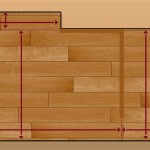Handsanded Laminate Flooring: A Detailed Overview
Handsanded laminate flooring represents a specific aesthetic choice within the broader category of laminate flooring. It aims to replicate the visual texture and subtle imperfections associated with traditional hardwood floors that have been manually sanded. This process gives the laminate a more authentic and rustic appearance, distinguishing it from smoother, more uniform laminate options. Handsanded laminate is typically chosen for its ability to add character and warmth to a space, mimicking the look of reclaimed or aged wood at a lower cost and with greater durability compared to actual hardwood.
Laminate flooring, in general, is a multi-layered synthetic product. The core is usually made of high-density fiberboard (HDF) or medium-density fiberboard (MDF), providing stability and impact resistance. On top of the core is a decorative layer, a high-resolution photographic image of wood grain, stone, or other patterns. Finally, a clear, durable wear layer protects the decorative layer from scratches, dents, and fading. Handsanded laminate flooring differentiates itself through the texture and pattern applied to the decorative and wear layers, simulating the uneven surface and imperfections of handsanded wood.
The manufacturing process for handsanded laminate involves specialized techniques to create the desired texture. This can include embossing in register (EIR), a process that aligns the surface texture with the printed grain pattern, enhancing the realism. The depth and variation of the sanding marks are meticulously controlled to achieve a balanced look – authentic enough to resemble real wood but not so extreme that it becomes impractical or aesthetically unappealing. The final product offers a cost-effective way to achieve the desired visual effect without the maintenance demands of genuine hardwood.
Understanding the Key Features of Handsanded Laminate Flooring
Handsanded laminate flooring possesses distinct features that contribute to its unique appeal and functionality. These features differentiate it from standard laminate options and dictate its suitability for various applications. Careful consideration of these features is crucial when selecting flooring for a particular space.
Firstly, the textured surface is the most defining characteristic. This texture, achieved through embossing or other surface treatment techniques, is designed to mimic the subtle undulations and imperfections left behind by hand sanding real wood. The texture not only enhances the visual realism but also provides a slightly improved grip underfoot compared to smooth laminate surfaces. The degree of texturing can vary between different manufacturers and product lines, ranging from subtle, barely perceptible imperfections to more pronounced and rustic sanding marks. Selecting the appropriate level of texturing is important to match the overall design aesthetic of the room.
Secondly, the durability and wear resistance are significant factors. Laminate flooring is generally known for its resistance to scratches, stains, and fading, and handsanded laminate is no exception. The wear layer, typically made of aluminum oxide, protects the decorative layer from everyday wear and tear. The Ac (Abrasion Class) rating indicates the floor's resistance to abrasion, with higher AC ratings signifying greater durability. For high-traffic areas, a higher AC rating is recommended to ensure the floor's longevity. The textured surface of handsanded laminate can also contribute to its durability by slightly camouflaging minor scratches and imperfections that may occur over time.
Finally, the ease of installation is a key advantage of laminate flooring, and this applies to handsanded laminate as well. Most laminate flooring products feature click-lock systems, allowing for a floating installation where the planks are connected to each other but not directly to the subfloor. This makes installation relatively straightforward, even for DIY enthusiasts. However, proper preparation of the subfloor is essential to ensure a stable and level surface. Uneven subfloors can cause the laminate planks to flex and potentially damage the locking mechanism. Proper underlayment is also important for sound absorption, moisture control, and added cushioning underfoot.
The Advantages of Choosing Handsanded Laminate Flooring
Choosing handsanded laminate flooring offers several advantages compared to other flooring options, particularly real hardwood and standard laminate. These advantages stem from its combination of aesthetics, durability, cost-effectiveness, and ease of maintenance. These benefits can make it an ideal choice for homeowners seeking a visually appealing and practical flooring solution.
One significant advantage is the cost. Handsanded laminate flooring is typically significantly less expensive than real hardwood. The price difference encompasses not only the initial material cost but also the installation expenses. Hardwood flooring often requires professional installation, while laminate flooring, with its click-lock system, can often be installed by homeowners, saving on labor costs. This cost-effectiveness makes handsanded laminate an accessible option for budget-conscious homeowners who desire the look of hardwood.
Another key benefit is the enhanced durability and resistance to wear and tear. Laminate flooring is designed to withstand heavy foot traffic, scratches, and stains. In contrast to hardwood, which is susceptible to water damage and requires regular refinishing to maintain its appearance, handsanded laminate is more resistant to moisture and easier to clean. The wear layer protects the decorative layer from everyday wear and tear, making it a practical choice for busy households with children and pets. The textured surface can also help to conceal minor scratches and imperfections, further extending the floor's lifespan.
Maintenance is also a significant advantage. Handsanded laminate flooring requires minimal maintenance compared to real hardwood. Regular sweeping or vacuuming is usually sufficient to keep the floor clean. For tougher stains, a damp mop with a mild detergent can be used. Unlike hardwood, laminate does not require waxing, polishing, or refinishing. This ease of maintenance saves time and effort, making it a convenient choice for homeowners with busy lifestyles.
Considerations When Selecting Handsanded Laminate Flooring
While handsanded laminate flooring offers numerous benefits, careful consideration should be given to specific factors before making a purchase. These factors will help to ensure that the chosen flooring product meets the specific needs and requirements of the space and the homeowner's preferences. Overlooking these considerations can lead to dissatisfaction and potential problems down the line.
Firstly, the quality of the laminate is paramount. Not all handsanded laminate flooring is created equal. The quality of the core material, the thickness and durability of the wear layer, and the realism of the printed image all contribute to the overall quality and longevity of the floor. Cheaper laminates may have thinner wear layers, less realistic textures, and less durable core materials, making them more susceptible to damage and wear. Researching different brands and reading reviews can provide valuable information about the quality and performance of various laminate products. Examining samples in person can also help to assess the realism of the texture and the overall aesthetic appeal.
Secondly, the intended use of the space is crucial. Different areas of the home have different flooring requirements. High-traffic areas, such as hallways and living rooms, require more durable flooring with a higher AC rating. Bathrooms and kitchens, where moisture is a concern, require water-resistant laminate flooring. Bedrooms, where comfort is a priority, may benefit from a thicker laminate with a sound-absorbing underlayment. Considering the specific needs of each room will help to narrow down the selection and ensure that the chosen flooring is appropriate for its intended use.
Finally, the overall aesthetic of the room should be taken into account. Handsanded laminate flooring is available in a wide range of colors, styles, and textures. Choosing a color and style that complements the existing decor and furnishings is essential for creating a cohesive and visually appealing space. Consider the lighting in the room and how it will affect the appearance of the floor. Lighter colors can brighten up a dark room, while darker colors can add warmth and sophistication. The texture of the laminate should also be considered in relation to the overall style of the room. A more rustic texture may be appropriate for a country-style or farmhouse-style decor, while a more subtle texture may be better suited for a more modern or contemporary setting.

Hand Applicator

The Must Have Tool For Flooring Professionals Marshalltown

Small Moq Lightweight Handheld Laminate Pvc Vinyl Hybrid Spc Floor Cutting Tool Flooring Cutter China Wpc Made In Com

Water Resistant Wood Floor Economic Portable Laminate Flooring China Laminated Made In Com

Water Resistant Wood Floor Economic Portable Laminate Flooring China Laminated Made In Com

Vinyl Vs Laminate Flooring Which Is Better Lx Hausys

Household Steam Mop Detachable Handheld Cleaner 370ml Water Tank Floor Steamer 3 Adjustable Levels With Cleaning Brush For Hardwood Laminate Tiles Grout Com

Handheld Edge Banding Trimmer Infinity Cutting Tools

Black Decker 3 In 1 Lightweight Corded Upright And Handheld Multi Surface Vacuum Ev1416 Com

Household Steam Mop Detachable Handheld Cleaner 370ml Water Tank Floor Steamer 3 Adjustable Levels With Cleaning Brush For Hardwood Laminate Tiles Grout Com
Related Posts








